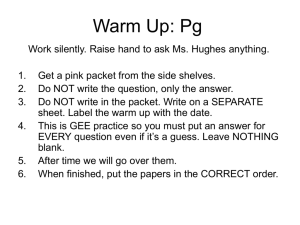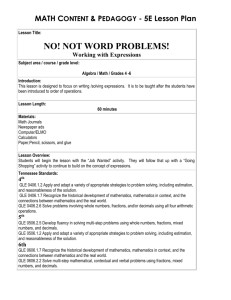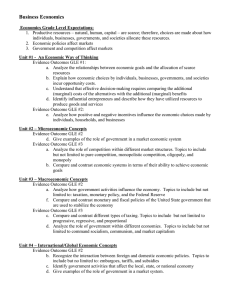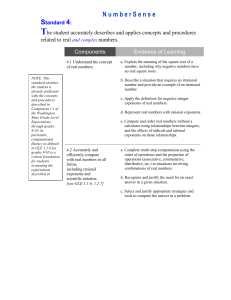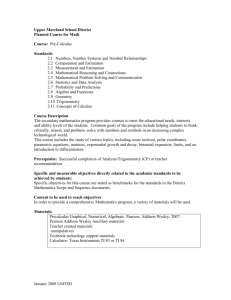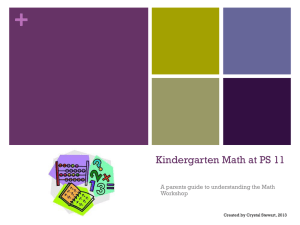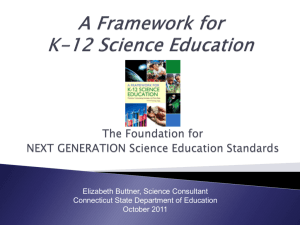CREC K-2 Science Stds Presentation - K
advertisement
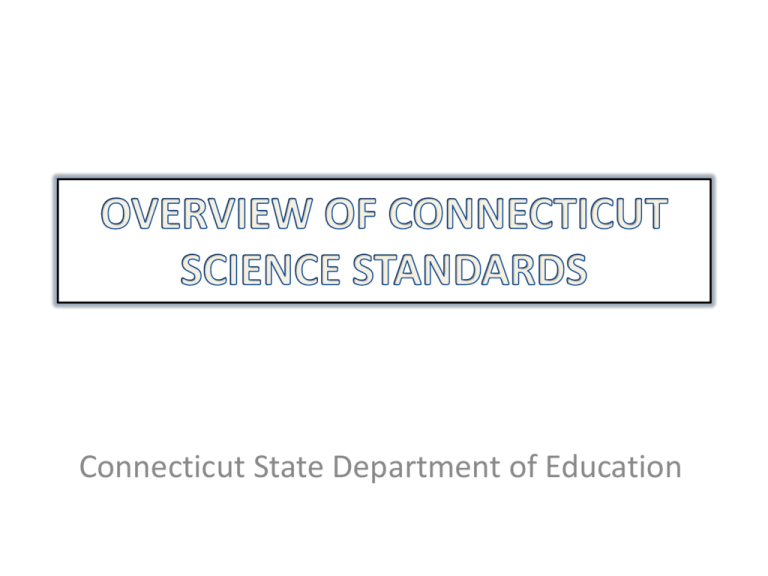
Connecticut State Department of Education Next Generation National Science Standards WHY? • 15 years since last national standards • Time to reflect on standards’ enactment and impacts • National and international science test scores • New research on how students learn science HOW? • 2010: NAS develops Guiding Principles, Domains and Core Ideas • 2011: Achieve leads standards-writing process • 2012: Standards published; states choose to adopt 2 Connecticut Science Standards Pop Quiz! 1. The Gr. 5 CMT assesses 5th grade science standards (True or False) 2. What is the difference between a Content Standard and an Expected Performance? 3. Content Standard 2.2, like all .2 standards, is an optional unit (True or False) 4. How does Content Standard K.4 relate to other kindergarten standards? 3 HIERARCHY OF SCIENCE STANDARDS: From Broadest Ideas to Measurable Student Outcomes • K-12 unifying theme Conceptual Theme and Essential Question • Enduring understanding (unit topic) • Key unit concept • Knowledge goals for 1-3 lessons Content Standard Unit Concept Underlying Concepts (GLCs) • Evidence of learning after several lessons (interim assessments). Range of Bloom's verbs and inquiry skills (INQs) Grade-Level Expectations (GLEs) 4 Anatomy of the Science Standards Follow along on the annotated sample page 5 Grade-Level Concepts (“GLCs”) • Unwrap underlying knowledge for each Framework Content Standard • Learning goals for the unit • Indicate scope and depth of learning unit • Suggested pacing: typically 1-3 lessons per concept statement • Suggested unit sequence • Key scientific literacy vocabulary • Some are assessed on CMT How can your district use unwrapped concept statements? • Aligning learning activities, selecting instructional materials, designing content-based professional development; 6 Grade-Level Expectations (“GLEs”) • What students should be able TO DO as evidence of learning • Interim assessments after a series of lessons • Measured primarily through classroom- and district-level assessments; some GLEs are assessed on CMT • Bloom’s Taxonomy - range of cognitive challenge • ALL students use higher order processes (not just recall) • Include some INQs merged with content • Districts may prioritize and modify GLE Uses: • Common formative and summative assessments, tracking student growth across grades (portfolios,) competency-based report cards, etc. 7 Assessment Expectations • Summative assessment of learning (end of unit, marking period or year) • Broad ideas (big picture) • Grades 3-10 Expected Performances indicate selected content sampled on CMT 8 QUESTIONS ABOUT ORGANIZATION AND USES OF SCIENCE STANDARDS? 9 Using Standards to Develop Assessments Remember… “Not everything that counts can be counted; not everything that can be counted counts.” -Albert Einstein 11 1. Give Context to the Task: “Why are we doing this?” • Learning activities/tasks should stimulate student ideas or be driven by students’ ideas; • Tasks need a purpose or a question worth investigating. Not…“Make these objects move” or “Count these leaves”. Science can provide an engaging context for applying mathematical content and practices Mathematics enables us to collect quantitative data, identify patterns, construct evidencebased claims, and communicate with precision 12 2. Look for Math/Science Connections Science Topics Kindergarten –objects in the classroom (K.1), living and nonliving things on the schoolyard (K.2) , weather conditions, building materials Gr. 1 – sun’s position, ways objects move, shadows, animal/plant parts, growth/change Gr. 2 – states of matter, plant life cycles, soils, nutrients Mathematics Skills • Kindergarten – counting by 10s, cardinality, comparing length & weight, adding & subtracting within 10, recognizing shapes, classifying and counting objects in a category • Gr. 1 – counting to 120, adding, subtracting, comparing lengths, how many in a category • Gr. 2 – using tools to measure length in std units, odd & even, counting by 5s, 10s and 100s, adding 2-digit numbers, drawing picture and bar graphs 13 3. Prioritize the MOST Important Standards to Assess • Look at the big idea in the Content or Practice Standards • Choose one GLE or numbered standard that most closely captures the essence of the standard • Choose one GLE or numbered standard that captures a high-leverage practice 14 Sample Science GLE Selection 2.1 – Materials can be classified as solid, liquid or gas based on their observable properties. GLE 1 – Compare and contrast the properties that distinguish solids, liquids and gases. (content) GLE 5 – Design a fair test to compare the flow rates of different liquids. (inquiry) 15 Sample Mathematics Standard Selection CC 2 Measurement and Data • Measure and estimate lengths in standard units • Relate addition and subtraction to length 6. Represent whole numbers as lengths… • Represent and interpret data 10. Draw a picture graph and bar graph… 16 Your turn… • Independently review Standard 2.2 • Select 2 important GLEs (content and inquiry) • Compare and discuss your choices with a partner • Work together to select 2 important GLEs for Standard 2.3 • Be prepared to share and justify your selections with the whole group 17 Qualities of Good Assessment Tasks 1. What do you think? Turn and talk… Interesting RelevantImportant - 2. What does the CREC K-2 Rubric say? – see Section 7 3. How would you define these terms: Meaningful Real world Multiple modalities – Meaningful feedback – Inform instruction 18 QUESTIONS ABOUT USING STANDARDS TO DEVELOP ASSESSMENTS? 19 Useful Resources - Science • Science Content Explanations – National Science Education Standards • AAAS Benchmarks On-line http://www.project2061.org/publications/atlas/ sample/toc.htm • Page Keeley’s Formative Assessment Strategies and Probes (Vol 1-4) 20 Useful Resources - Mathematics • A Model for Mathematics Curriculum for Grades PreK-8 Correlated GOALS 2000 Criterion Referenced Test • Uncovering Student Thinking • NCTM K-2 Assessment Sampler 21 CSDE Science Consultant: Liz Buttner 860-713-6849 elizabeth.buttner@ct.gov CSDE Mathematics Consultant: Charlene Tate Nichols 860-713-6757 charlene.tate.nichols@ct.gov 22
